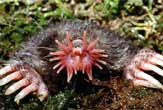
Moles do a lot of digging, as many gardeners know. But they don't use whiskers to find their way around in the dark. Instead, they simply follow their noses.
A new detailed study of tiny touch receptors, called "Eimer's organs," on the tip of a mole's nose reveals how the animals do it.
For moles, the Eimer's organs serve the function of whiskers found in most small mammals and fingers in humans. By touching their noses to the ground repeatedly, the animals explore their surroundings and discriminate between different objects.
Using fluorescent dyes, the researchers found that the Eimer's organs in the coast mole and the odd-looking star-nosed mole are composed of a column of skin cells, around which numerous nerve endings are arranged. An outer ring of nerves interlacing the column function as high-threshold pain receptors, while nerves within the cell column act as low-threshold touch receptors.
The researchers think that this organization allows the outer nerves to sense abrasive or potentially harmful areas before the more sensitive inner nerves come into contact with them.
The study, by Paul Marasco of Vanderbilt University in Tennessee and colleagues, is detailed in this week's issue of the journal for the Proceedings of the National Academy of Sciences.
Get the world’s most fascinating discoveries delivered straight to your inbox.


